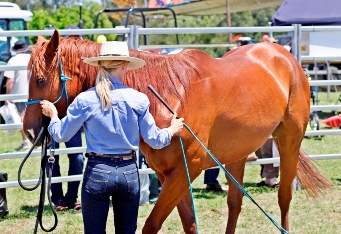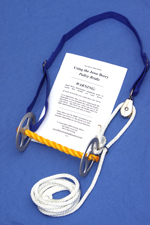 Want Your Horse To Stop If This Happened?
Want Your Horse To Stop If This Happened?
In rodeo competitions, the rider chases a calf. The horse zooms up next to the calf, and at the right moment, the cowboy slides off his horse, onto the calf, and the wrestling match begins.
The horse is trained to do run up to and along side the calf so the cowboy can do his thing.
But what if you’re not as good at riding a horse as these guys?
What if you have a son or daughter who you worry about falling off the horse and the horse doesn’t stop?
That would be especially bad if a foot was caught in the stirrup.
Ouch.
Would you rather have a horse taught to stop or slow down if you’re falling off?
Why would you want that?
Well, if you’re not a rodeo-er or into Dressage, etc., then chances are you’re more into trail ridin’ and easy goin’ stuff.
T’ain’t nothin’ wrong with that. In fact, that’s a very big portion of the horse industry today.
So if you’re not an experienced rider, break easier ‘n you used to, and want your horse to stop if you fall off or maybe even slow down if he feels you slipping, that can be done.
Diana Quintana, one of our featured trainers, teaches that very thing to horses.
She’ll take a ‘deflated innertube’ (with the stem removed) and put it on a horse.
She’ll start by having the horse walk around with it on. Not trot or lope…walk. (I might add the horse may need to get used to it being on his back first. You can’t always throw it on and go.)
Anyway, once the tube is on, have the horse walk a calm, steady pace.
As he does, watch for the inner tube to come off… because it will.
As it starts to slip, the horse will notice it. That’s the horse’s cue…when it starts to slip. That mimics a rider starting to slip off.
Then when the tube hits the ground, stop the horse.
And once it’s on the ground around the horses feet, you want him to accept it and not freak out about it.
You want him calm and cool about it.
Why?
Because you always want your horse to remain calm and cool regardless of the situation. That way, you don’t have to fight a thousand pounds of out-of-control muscle.
Instead, it’s taught self control.
When you get him doing this well at the walk then you can go to the trot – but not until then.
Now there’s a little more to it than what I told you because words don’t do it justice, some things ought to be seen for clarity.
But you get the gist.
And if you haven’t yet seen Diana’s video, you might take a look at it. To read about it, click the following:


